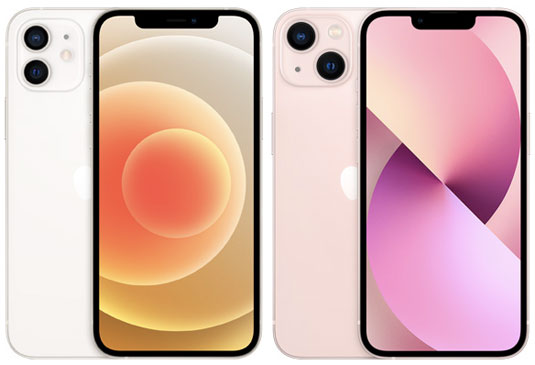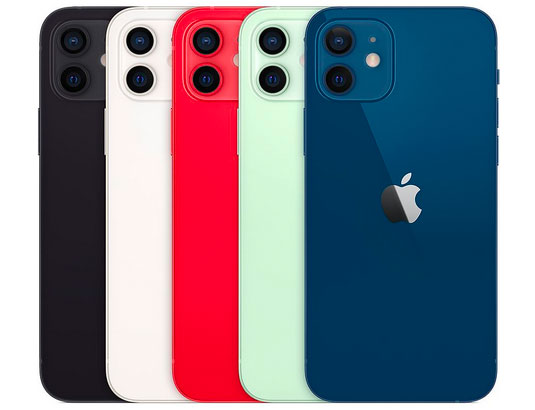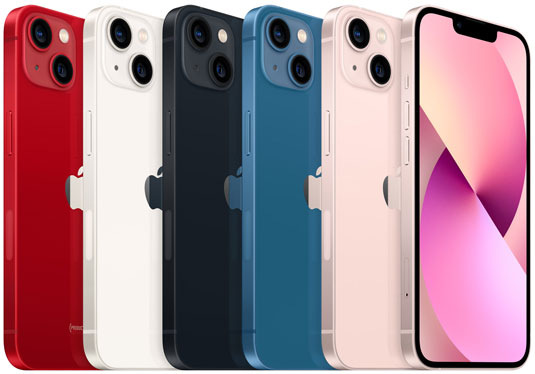Hosted by site sponsor WebMate.
iPhone Q&A
Update Published September 23, 2025
All Apple Q&As >> iPhone Q&A (Home)
To be notified of new Q&As, sign up for EveryMac.com's bimonthly email list.
What are the major differences between the iPhone 13 (2021) and the iPhone 12 (2020)? Which is best for me?
Note that the iPhone 12 and iPhone 13 models all have been discontinued. However, this Q&A has been updated with current iOS support and other details to be helpful to anyone buying one of these models on the used market.
There are four different iPhone 12 models and five different iPhone 13 models, but this EveryiPhone.com Q&A primarily covers collective differences to make it straightforward to determine which device is best for you.

Photo Credit: Apple, Inc. (Left: iPhone 12; Right: iPhone 13)
Although the different rear cameras and front "notches" make visible differentiation straightforward when the two devices are side-by-side, the iPhone 12 and iPhone 13 are easy to mistake for one another (and for other iPhone models, as well). There are some notable differences that are not as apparent, also.
External Design & Functionality Differences
Both the iPhone 12 and iPhone 13 are a rounded rectangle design with a glass front and back and an aluminum case with flat edges. Both models have a "Ceramic Shield" over the display for increased durability and are waterproof to the IP68 standard for up to 30 minutes of water exposure to a depth of six meters.
Both models also have stereo speakers, a Lightning port, a side-mounted Nano SIM access panel for one or two physical SIMs (depending on model), and support Face ID authentication. They both support "wireless" -- really inductive -- charging with an optional charging base and magnetic "MagSafe" charging, as well.
Both models have quality displays -- a 6.1" OLED HDR "Super Retina XDR" display (2532x1170, 460 ppi, 2 million:1 contrast ratio) -- but the display on the iPhone 13 is a bit brighter than its predecessor (800 nits of typical max brightness compared to just 625 nits). The iPhone 13 is a tiny bit thicker and heavier, too:
 iPhone 12 |
 iPhone 13 |
|
| Material: | Aluminum/Glass | Aluminum/Glass |
| Display: | 6.1" OLED | 6.1" OLED |
| Resolution: | 2532x1170 | 2532x1170 |
| Brightness: | 625 nits | 800 nits |
| Screen Notch: | Yes | Yes (20% Smaller) |
| Speakers: | Stereo | Stereo |
| Inductive Charging: | Yes (Qi) | Yes (Qi) |
| MagSafe Charging: | Yes | Yes |
| Dimensions (In): | 5.78 x 2.82 x 0.29 | 5.78 x 2.82 x 0.30 |
| Weight: | 5.78 oz. (164 g) | 6.14 oz. (174 g) |
Housing Color Differences
The iPhone 12 and iPhone 13 both have five colors options, but they are not the same colors.

Photo Credit: Apple, Inc. (iPhone 12 Colors)
The iPhone 12 (above), shipped with in black, white, (PRODUCT) RED, pale green, and dark blue color options, left to right. The iPhone 13 (below) shipped with (PRODUCT) RED, "Starlight" (a light, warm gray), "Midnight" (black), blue, and (pale) pink color options, left to right.

Photo Credit: Apple, Inc. (iPhone 13 Colors)
The color offerings are quite different between lines. In person, (PRODUCT) RED is a darker tone on the iPhone 13 than the iPhone 12. "Starlight" can almost look white in certain light, but it is more of a warm gray.
Camera Differences
The cameras in the iPhone 12 and iPhone 13 are a notable point of differentiation, especially the rear camera.
Front Cameras
The front-facing camera on both models -- which Apple calls "TrueDepth" -- support Face ID authentication, augmented reality (AR), still photos, and video, but the iPhone 13 adds more advanced HDR video, "Cinematic mode" for a shallow depth of field effect, and other software tweaks courtesy of its more advanced processor:
 iPhone 12 |
 iPhone 13 |
|
| Megapixels: | 12 MP | 12 MP |
| Aperture: | f/2.2 | f/2.2 |
| Video: | 4K | 4K |
| Dolby Vision HDR: | 4K 30 fps | 4K 60 fps |
| Cinematic Mode: | No | Yes |
| Photographic Styles: | No | Yes |
Rear Cameras
The rear camera in both the iPhone 12 and iPhone 13 shoot 4K video and stills and both have dual cameras, but the iPhone 13 adds "Cinematic mode" for a shallow depth of field effect like the front camera as well as sensor-shift optical image stabilization and software improvements, as well:
 iPhone 12 |
 iPhone 13 |
|
| Megapixels: | 12 MP x2 | 12 MP x2 |
| Ultra Wide Angle: | f/2.4 | f/2.4 |
| Wide Angle: | f/1.6 | f/1.6 |
| Telephoto: | None | None |
| Dolby Vision HDR: | 4K 30 fps | 4K 60 fps |
| OIS: | Yes | Sensor-Shift |
| Cinematic Mode: | No | Yes |
| Digital Zoom: | 2x (Out), 5x (Up) | 2x (Out), 5x (Up) |
In basic terms, the sensor-shift optical image stabilization (OIS) on the iPhone 13 stabilizes the sensor, instead of just the lens, which improves image sharpness and quality.
Identification Differences
Despite their telltale rear camera differences, the iPhone 12 and iPhone 13 are easy to mix up. It is not possible to visually identify specific iPhone 12 or iPhone 13 models, either.
Accordingly, one relatively simple way to uniquely identify the iPhone 12 and iPhone 13 models is by the Model Number listed on the cardboard shipping box and within the iOS "Settings" app.
Consequently, for the purpose of this Q&A, it is sufficient to note that the following model numbers refer to these iPhone devices:
iPhone Model |
Model No |
EveryiPhone.com's Ultimate iLookup feature also can precisely identify these iPhone models by Order Number (referred to as "Model" within the iOS "Settings" app under General > About).
Battery Life Differences
The iPhone 12 and iPhone 13 each have excellent battery life, but the iPhone 13, remarkably, is even better:
 iPhone 12 |
 iPhone 13 |
|
| Streamed Video: | 11 Hours | 15 Hours |
| Video Playback: | 17 Hours | 19 Hours |
| Audio Playback: | 65 Hours | 75 Hours |
Wireless Connectivity & Data Differences
There are specific 5G band differences for different iPhone 12 and iPhone 13 models depending on where either is sold, but they all support fast 5G capability.
The iPhone 12 and iPhone 13 models also support dual SIMs, but only China-specific models have dual hardware Nano SIMs. iPhone 12 models sold in other countries have one hardware Nano SIM and one eSIM in software. The iPhone 13 models outside of China not only support one hardware Nano SIM and one eSIM in software, but alternately support the option of two eSIMs; a first for the iPhone.
Internal Differences
The iPhone 12 and iPhone 13 are significantly different internally:
 iPhone 12 |
 iPhone 13 |
|
| Clockspeed: | 3.0 GHz | 3.2 GHz |
| Processor: | Apple A14 Bionic | Apple A15 Bionic |
| Cores: | Six | Six |
| RAM: | 4 GB | 4 GB |
| Neural Engine: | 4th Gen | 5th Gen (16 Core) |
| Storage: | 64/128/256 GB | 128/256/512 GB |
| 5G Capability: | Yes | Yes |
In benchmark tests, the iPhone 13 is in the ballpark of 8% to 13% faster than the iPhone 12.
iOS Support Similarities
The iPhone 12 originally shipped with iOS 14; the iPhone 13 with iOS 15. Both models later shipped with iOS 15 and then iOS 16.
When running iOS 16, nether the iPhone 12 nor the iPhone 13 support the minor Accessibility Detection feature. The iPhone 12 also does not support the improved Depth of Field feature, but the iPhone 13 does have this capability.
Feature support is the same for iOS 17, as well. The iPhone 12 and iPhone 13 do not support the minor Point and Speak accessibility functionality, but otherwise support the operating system. The "Pro/Pro Max" models from both lines do support Point and Speak, though.
Finally, support for iOS 18 and iOS 26, the current version of the iOS, is the same for all of these models. All support these operating systems, but none support the Messages via Satellite or Apple Intelligence (AI) features.
iPhone 12 & iPhone 13 Comparison Chart
These differences as well as other details and pricing information is summarized below:
 iPhone 12 |
 iPhone 13 |
|
| Introduced: | Oct 2020 | Sep 2021 |
| Discontinued: | Sep 2023 | Sep 2024 |
| Processor: | 3.0 GHz A14 | 3.2 GHz A15 |
| RAM: | 4 GB | 4 GB |
| Storage: | 64/128/256 GB | 128/256/512 GB |
| Battery Life: | 11-65 Hours | 15-75 Hours |
| Display Type: | OLED | OLED |
| Display Size: | 6.1" | 6.1" |
| Resolution: | 2532x1170 | 2532x1170 |
| Pixel Density: | 460 ppi | 460 ppi |
| Brightness: | 625 nits | 800 nits |
| Front Camera: | 12 MP (4K) | 12 MP (4K) |
| Rear Camera: | 2 (12 MP) | 2 (12 MP) |
| Dolby Vision HDR: | 4K 30 fps | 4K 60 fps |
| OIS: | Yes | Sensor-Shift |
| Cinematic Mode: | No | Yes |
| Material: | Alum/Glass | Alum/Glass |
| MagSafe: | Yes | Yes |
| SIM Card: | Nano/eSIM | Nano/eSIM x2 |
| 5G Cellular: | Yes | Yes |
| Original iOS: | iOS 14 | iOS 15 |
| Maximum iOS: | iOS 26 | iOS 26 |
| Orig. Price* (US): | US$829 US$879 US$979 |
US$799 US$899 US$1099 |
* Note that these prices were for devices unlocked and paid in full upfront. Carrier subsidized options also were available. On September 14, 2021, Apple cut the price of the iPhone 12 configurations to US$699, US$749, and US$849, respectively. On September 7, 2022, Apple cut the price of the iPhone 12 to US$599, US$649, and US$749 and the price of the iPhone 13 to US$699, US$799, and US$999, both respectively. Finally, on September 12, 2023, Apple discontinued the iPhone 12 and cut the price of iPhone 13 to US$599, US$699, and US$899.
For pricing in dozens of countries, see the "Global Prices" on the specs page for each iPhone as well as the "By Global Original Prices" section of EveryiPhone.com.
So, which is for me? Should I buy an iPhone 12 or iPhone 13?
Just between the iPhone 12 and iPhone 13 (and ignoring subsequent models), it can be a challenging decision because the devices are quite close together in capability. The iPhone 12 originally cost US$100 less (or US$50 less if both devices were configured with 128 GB of storage).
If you can put the extra storage to good use, the iPhone 13 also will get you (1) a bit faster performance, (2) a modestly brighter display, (3) a modestly better rear camera, (4) significantly improved battery life, and (5) dual eSIM support (outside of mainland China). Running iOS 16 (or later), the iPhone 13 also will get you (7) the improved Depth of Field photographic capability.
Although the value proposition has shifted somewhat on the used market, the iPhone 12 should still be a bit cheaper than the iPhone 13. Whether or not these modest feature improvements are worth the extra money to you is a personal decision. For some users, the significant improvement in battery life alone might be well worth the extra money for the iPhone 13.
However, because the battery life of the iPhone 12 also is quite respectable and the speed, display, and camera differences are not earth-shattering, many users -- especially those on a tight budget -- likely would be best served by buying an iPhone 12, particularly given even lower prices on the used market. However, these older iPhone models likely will not support the current version of the iOS for quite as long and that should be taken into account, as well.
In the US, site sponsor Other World Computing sells used and refurbished iPhone models with free shipping. On the other hand, if you need to sell an iPhone, A+ BBB-rated Cash for Your Mac and GoRoostr will buy your older iPhone with an instant quote and prompt payment.
Please also see EveryiPhone.com's Ultimate iComparison feature to dynamically compare any iPhone model to any other iPod, iPhone, or iPad.
Permalink | Report an Error/Typo | Sign Up for Site Update Notices
<< iPhone Q&A (Main) | All Apple Q&As
Established in 1996, EveryMac.com has been created by experts with decades of experience with Apple hardware. EveryMac.com includes, and always has included, original research incorporating detailed, hands-on inspection of packaging, computers, and devices as well as extensive real-world use. All information is provided in good faith, but no website or person is perfect. Accordingly, EveryMac.com is provided "as is" without warranty of any kind whatsoever. EveryMac.com, and the authors thereof, shall not be held responsible or liable, under any circumstances, for any damages resulting from the use or inability to use the information within. For complete disclaimer and copyright information please read and understand the Terms of Use and the Privacy Policy before using EveryMac.com. Copying, scraping, or use of any content without expressed permission is not allowed, although links to any page are welcomed and appreciated.
